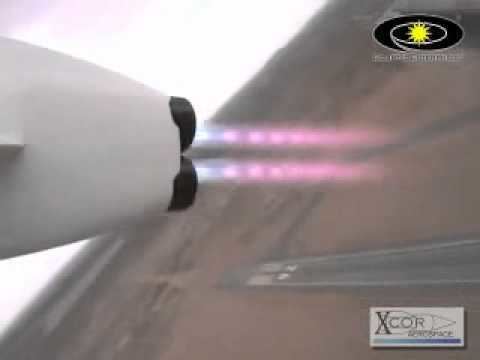Engine type Liquid-propellant rocket | Manufacturer XCOR Aerospace | |
 | ||
2002 jul 11 xcor ez rocket test flight 13 ground view
The XCOR EZ-Rocket is a test platform for the XCOR rocket propulsion system. The airplane is a modified Rutan Long-EZ, with the propeller replaced by first one, then later a pair of pressure-fed regeneratively cooled liquid-fuelled rocket engines and an underslung fuel tank. The engines are restartable in flight, and are contained within Kevlar armor shielding. The EZ-Rocket is registered as an experimental aircraft.
Contents
- 2002 jul 11 xcor ez rocket test flight 13 ground view
- 2002 jul 11 xcor ez rocket test flight 13 rocketcam view
- Development and history
- Milestones and records
- Derivatives
- Specifications
- References
2002 jul 11 xcor ez rocket test flight 13 rocketcam view
Development and history
The first flight took place on July 21, 2001, flown by test pilot Dick Rutan.
On a typical flight, the EZ-Rocket takes off on rockets, gains altitude for a minute or so, then switches off the rockets and glides to a deadstick landing.
The vehicle actually flies better during deadstick glide landings than a Long-EZ due to lack of drag from a stationary pusher propeller — the vehicle's aerodynamics are cleaner in spite of its belly tank. It is also lighter due to the lack of a piston engine (the rocket propulsion system is significantly lighter), so enjoys significantly lower wing loading than a stock Long-EZ.
When XCOR began flying its EZ-Rocket in 2001, the company decided to have it FAA certified as an experimental aircraft, avoiding the additional time required to seek a launch vehicle license from the Office of Commercial Space Transportation (AST). Jeff Greason, a co-founder of XCOR, said on February 10, 2003 if they were starting out at that time they probably would seek an AST license due to the progress made in developing a regulatory regime for suborbitals.
Milestones and records
Derivatives
The Rocket Racing League aircraft currently in development, the Mark-III X-racer, is a design descendant of the EZ-Rocket aircraft. Although XCOR is not the developer of the rocket engine for the Mark-III, XCOR did develop the rocket engine for the Mark-I X-Racer, the first of the X-Racers to use a single rocket engine on a Velocity SE basic airframe, and the first X-Racer to utilize kerosene instead of isopropyl alcohol fuel. XCOR used both design and operational experience from the EZ-Rocket in the Mark-I rocket aircraft design.
